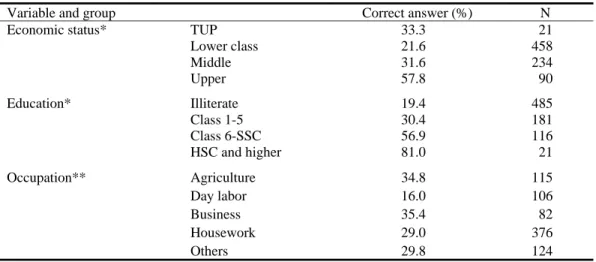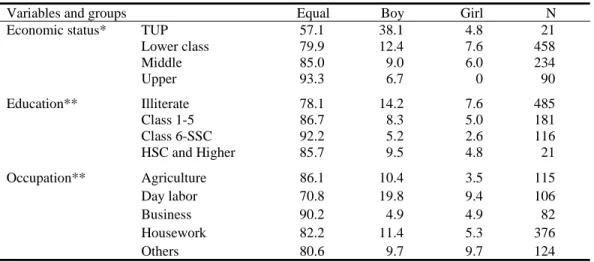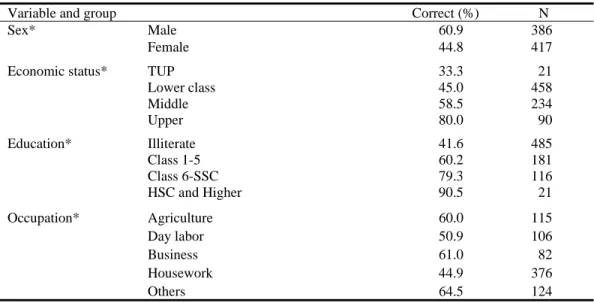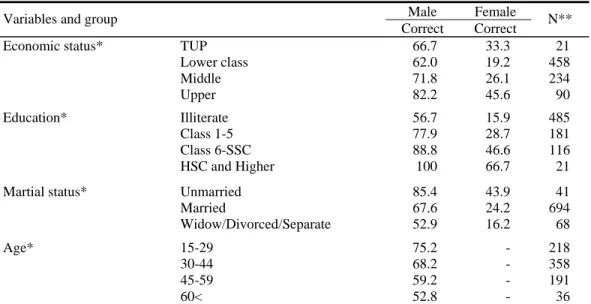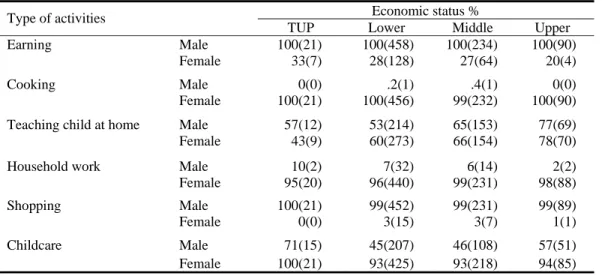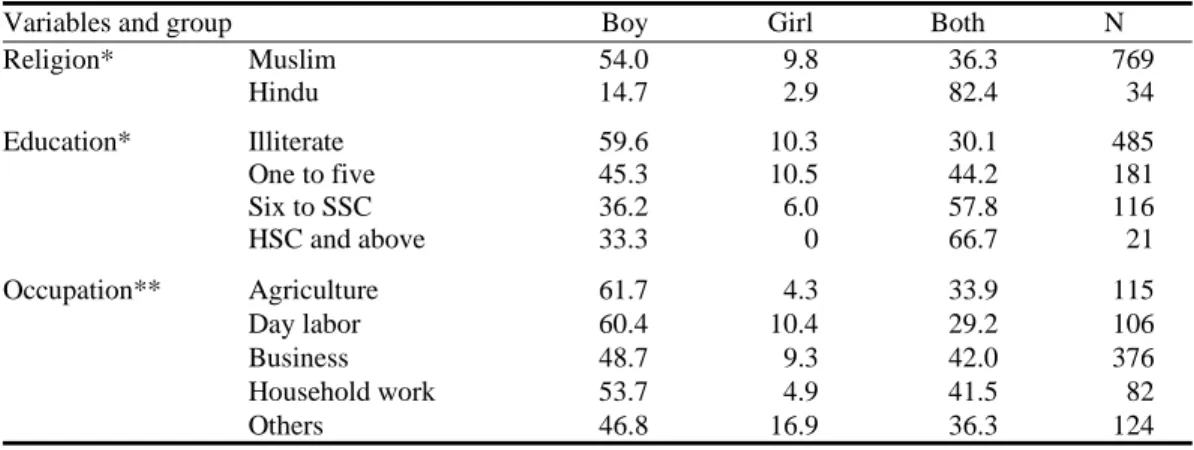The findings indicate that respondents' knowledge of diet, education, voting age, and marriage was adequate. Both positive and negative statements were taken into account to obtain a balanced attitude from the respondents. The majority of the respondents were married (86%) and Muslim (96%) and 32% of the total are involved in NGO activities.
It was found that the higher the education level, the better the knowledge level of the respondent (Table 3). Twelve percent said that boys should be given more food, while 6% of respondents preferred girls. The majority of the respondents were aware of the necessity to provide equal amount of food for both son and daughter (Table 4).
More than half of respondents engaged in agriculture, entrepreneurship and other professions are aware of the minimum voting age. Respondents' knowledge of the criminality of the transaction for transactional dowry and the legal procedure for divorce was measured. The majority of respondents aged 15 to 29 and unmarried know the minimum marriage age for men (Table 9).
On the other hand, most of the respondents from different economic categories including married, single and widowed are ignorant about the minimum age of marriage for women.

PERCEPTION
The following tables show that there are no significant differences among the respondents regarding the expectation of a child, the necessity of education, the priority of treatment, excessive food intake, decision-making in the household and participation in social activities. Being essentially the overall head of the household, the husband and boy had a great advantage over the woman and girl. Expecting a son as the first child in the family, all economic categories and illiterate respondents preferred a boy to a girl, while the educated (HSC and above) preferred girls to boys (Table 11).
Nearly half of Hindus (44%) would like to have a boy or a girl as their first child. In the case of treatment, most respondents believed that the spouse was important to heal first, but 20% of respondents believed that both should be treated at the same time. Looking in detail based on different occupational groups, gender, religion and education category, all of them preferred husband instead of wife.
Similar results were found regarding the issue of providing excess food for men and boys than women and girls (Table 16). Therefore, respondents do not have different views on the demand for food for family members. In total, 81% and 78% of the respondents emphasize with more enthusiasm the man and the son than the woman and the daughter about the necessity of food.
Respondents across age, gender, marital status, NGO membership and education except those with higher education (HSC and above) expressed that men and boys should be given surplus food. The results show that 53% of the total respondents believed that both husband and wife should decide to buy and sell any kind of household assets and use the sale proceeds. On the other hand, the perception was not much different between men and women for the decision to sell land and rickshaw.
In the case of domestic goods and livestock, the husband and wife had priority in deciding on the purchase, sale and use of the sale proceeds compared to the husband himself. Mother-in-law turned out to be less important when deciding on buying, selling and spending the proceeds from the sale. Although this issue is particularly related to women and is a sign of women's empowerment, the findings show that not only did men discourage women from participating in village banter, but women themselves were not interested in actively engaging in banter.
The results show that almost all the respondents (91 to 100%) had a similar opinion in this regard (Table 19). Findings show that 49% of the respondents supported that parents should decide on their daughter's marriage while 25% thought that fathers should decide it.
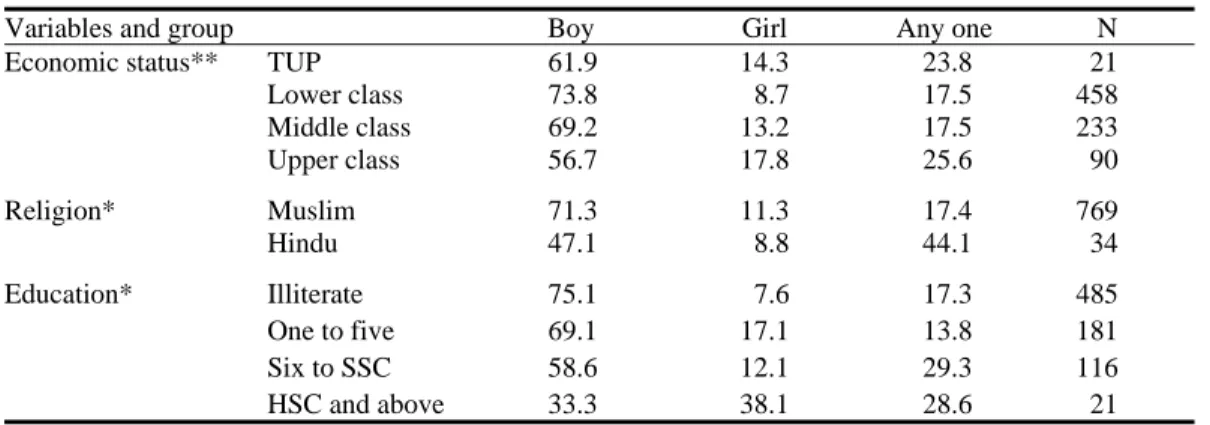
ATTITUDE
For the topic of general perception towards gender, the qualitative part reinforces the findings of the quantitative part of the study. The objective of the section is to assess the attitude towards discrimination between men and women; and boy and girl in terms of nutrition, education, value of work, etc. Again, respondents with more years of schooling had a more favorable attitude than those with less schooling.
Those respondents who said that boys' education was more important were rationalized by the belief that in the future boys would probably get a job and take care of the family, while the girl would go to someone else's house after marriage. On the other hand, another respondent said that boys' education is especially important for poor families. The survey shows a more positive attitude towards gender discrimination, meaning that most respondents had positive views about equal treatment of men/women and boy/girl.
This bias is apparently implicit in education because of their perceived potential as future breadwinners for the family. Almost a fifth of the respondents had a more favorable attitude towards the issue, while approximately the same percentage (20.3%) had a less favorable attitude (table 28). Different categories in education, economic and marital status are associated with attitudes towards empowerment and these associations are statistically significant (Table 29).
Results of the in-depth interviews confirm the existing belief found in the quantitative analysis that overall control of the decision-making on household properties should remain with men. Some comments: "What do women know about justice?" and "Mind your own business, you will not take your wife to dorbar." Interestingly, women themselves also reveal the unfavorable attitude towards social mobility of women. In terms of ownership of resources, participation of women in shalish and their free mobility perception and attitudes of the respondents are illustrated to be identical as it is implemented in reality.
Sex, economic status, education and occupation of the respondents are significantly related to the scores (Table 30). According to one respondent, "Beating is not bad, it reduces anger." The girls could have been kept under strict control through beatings, one replied. There is a broad consensus on the negative consequences of physical violence in quantitative and qualitative data.
Almost half of the respondents (48%) had a more favorable attitude, while 8.3% had a less favorable one (Table 31). This suggests that views on the role of gender in the family and society do not influence issues of empowerment and marriage.

DISCUSSIONS AND CONCLUSION
- General perception on gender
- Gender discrimination
- Empowerment
- Violence against women
- Marriage
Women's job is to give birth to children and take care of them; men should earn money. As women currently work outside the home, men should also help with household chores such as washing clothes, cooking appliances, etc. Meanwhile, the woman's husband or other elderly relative is not in the house.
In this situation, the woman should go to his father with the permission of anyone. If there are needs in the family, it is natural for the husband to be angry. So it is natural for parents, relatives to pressure the bride for the rest of the dowry.
Some people think that women's character can be compromised if they are not strictly controlled (beaten, not allowed to go outside, etc.). Even if the husband does not allow the wife to go to her parents' house by force, the wife must still obey the husband. Some say it has become so difficult to maintain women's chastity that they should be married off at the age of 14-15.
